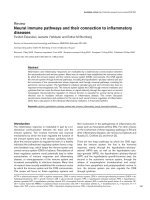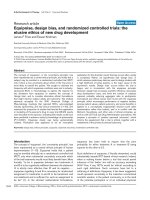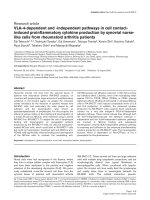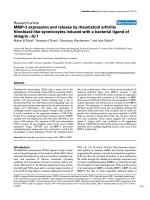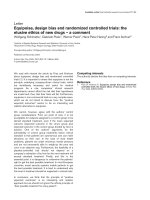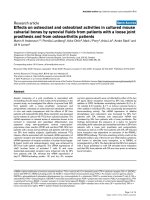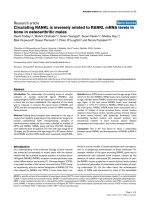Báo cáo y học: "Circulating immune complexes and complement C3 and C4 levels in a selected group of patients with rhinitis in Lebanon" pot
Bạn đang xem bản rút gọn của tài liệu. Xem và tải ngay bản đầy đủ của tài liệu tại đây (233.85 KB, 4 trang )
BioMed Central
Page 1 of 4
(page number not for citation purposes)
Clinical and Molecular Allergy
Open Access
Research
Circulating immune complexes and complement C3 and C4 levels
in a selected group of patients with rhinitis in Lebanon
Alexander M Abdelnoor*
1
, Firas Kobeissy
1,2
, Daad Farhat
1
and
Usamah Hadi
3
Address:
1
Department of Microbiology & Immunology, Faculty of Medicine, American University of Beirut, P. O. Box 11-0236, Riad el-Solh, Beirut,
11072020, Lebanon,
2
Department of Neuroscience, University of Florida, Gainsville, FL, 32608, USA and
3
Department of Otolaryngology, Faculty
of Medicine, American University of Beirut, P. O. Box 11-0236, Riad el-Solh, Beirut, 11072020, Lebanon
Email: Alexander M Abdelnoor* - ; Firas Kobeissy - ; Daad Farhat - ;
Usamah Hadi -
* Corresponding author
Abstract
Background: A number of reports indicate that circulating immune complexes (CIC) and
activation of the complement system contribute to the pathogenesis of Type I allergy. The aim of
this study was to investigate the status of CIC in 113 patients with rhinitis in Lebanon and
determine complement components C3 and C4 serum levels in the CIC-positive patients. Serum
specific IgE antibodies were previously detected and reported in 74 of the 113 patients.
Methods: CIC were detected by polyethylene glycol precipitation and serum C3 and C4 levels
quantified by radial immunodiffusion.
Results: CIC was positive in 20 of the specific IgE-positive and 13 of the specific IgE-negative
patients. C3 and C4 levels were within the normal range in all the 33 CIC-positive patients.
Conclusions: The antibody class that constitutes the complexes does not seem to be IgG or IgM.
Moreover, complement activation does not seem to be involved in the allergic reaction since both
C3 and C4 levels were normal in all patients. The role of these complexes, if any, in the
pathogenesis of rhinitis is yet to be determined.
Background
In atopic individuals, exposure to an allergen would result
in the production of specific IgE antibodies that bind to Fc
receptors (FcεRI) on tissue mast cells and basophils. On
re-exposure, the allergen cross-links bound IgE molecules.
This results in the immediate release of histamine and var-
ious enzymes from these granulated cells. Later, prostag-
landins and leukotrienes are produced as a consequence
of arachidonic acid metabolism, and released. Moreover,
Th2 cytokines are generated and there is an influx of cells,
in particular, eosinophils into the site of allergen entry. In
this Type I reaction, the mediators released from the cells
(mast cells, basophils, Th2-lymphocytes, eosinophils)
cause increases in blood flow and vascular permeability,
contraction of smooth muscle and tissue damage leading
to the signs and symptoms that are observed [1].
Some reports indicated that activation of the complement
system by an allergen or immune complex would result in
the generation of anaphylatoxins (C3a, C4a, and C5a).
These anaphylatoxins would amplify mast cell degranula-
tion leading to an increased Type I response [2-7].
Published: 22 April 2004
Clinical and Molecular Allergy 2004, 2:6
Received: 30 December 2003
Accepted: 22 April 2004
This article is available from: />© 2004 Abdelnoor et al; licensee BioMed Central Ltd. This is an Open Access article: verbatim copying and redistribution of this article are permitted in
all media for any purpose, provided this notice is preserved along with the article's original URL.
Clinical and Molecular Allergy 2004, 2 />Page 2 of 4
(page number not for citation purposes)
Atopic rhinitis is caused by the inhalation of allergens
(foreign proteins) that induce the above-described Type I,
and possibly Type III reactions. Avoiding contact with the
allergen, if possible, and desensitization usually improves
the condition of the patient.
The aim of this study was to detect the presence of CIC
and determine the serum levels of C3 and C4 in patients
and to see if a correlation existed between these parame-
ters and allergic rhinitis.
Methods
Subjects and blood specimens
One hundred and thirteen patients with rhinitis (65
females, 48 males, age range between 6 and 82 years) were
included in the study. Criteria used to diagnose rhinitis
included history, nasal obstruction, rhinorrhea and nasal
itchiness. Blood was collected from each patient in a plain
vacutainer, allowed to clot, the serum separated and
stored at -20°C till performance of tests.
Circulating Immune Complexes [8]
Nine parts of 4.166% polyethylene glycol in borate buffer
were added to 1 part of a 1:3 dilution of serum to be
tested. The mixture was allowed to stand at room temper-
ature for 1 hour, after which the absorbance at a wave-
length of 450 nm was read using the patients' serum as a
blank. Absorbance greater than 0.23 were considered
positive.
Complement C3 and C4 Levels
Five µl of serum were loaded into wells of ready to use C3
and C4 radial immunodiffusion plates (The Binding Site
LTD., Birmingham, UK). Forty-eight hours later, the diam-
eters of the white rings of precipitation formed were meas-
ured and concentrations of C3 and C4 were determined
using the provided conversion table.
Experimental research on humans
Approval for this research project was obtained from the
Institutional Research Board and is in compliance with
the Helsinki Declaration.
Results and discussion
Earlier we reported on the frequency of causative allergens
in groups of perennial asthmatics and rhinitics [9,10]. The
most common causative allergen in these patients was
house dust mite. Specific anti-allergen IgE antibodies were
detected in 74 of the 113 patients with rhinitis (65.5%).
Dermatophagoides pteronyssinus (Dpt) was the causative
allergen in 62, Dermatophagoides farinae (Df) in 58, cat
hair dander in 23 and dog hair dander in 9 patients (some
patients were allergic to more than one allergen).
The presence of CIC in sera of patients was detected by a
method reported by Riha et al. [8]. It involves the precip-
itation of CIC by polyethylene glycol and determining the
absorbance of the turbidity produced at a wavelength of
450 nm using patients' serum as a blank. The results
obtained paralleled those obtained when the C
1q
assay
was used. The absorbance values they obtained when sera
obtained from apparently normal individuals were all less
than 0.200. Their analysis of the precipitates formed using
sera from 20 patients with diseases other than allergy indi-
cated that IgM was present in all of them, IgG in 18 and
IgA in 4. In the present study, CIC were detected in 33 of
the 113 (29%) rhinitics, 20 (17.7%) of which also had IgE
specific anti-dust mite antibodies (Table 1). In studies
done earlier in our laboratory 4 of 61 (6.6%) apparently
normal individuals were CIC-positive using polyethylene
glycol precipitation to detect them (unpublished data).
This value is significantly less than that obtained in the
rhinitis patient group.
CIC can cause tissue injury by several ways [11]. IgG
(excluding IgG
4
) and IgM class antibodies in the form of
complexes with antigen activate the classical pathway of
the complement system resulting in products that lead to
inflammation. Independent of complement, CIC-con-
taining IgG could bind to F
c
receptors expressed by various
cell types including macrophages, neutrophlis, eosi-
nophils and platelets inducing them to release a number
of mediators that contribute to the signs and symptoms
observed in rhinitis.
Table 1: Specific IgE (sIgE) antibodies, circulating immune complexes (CIC) and mean complement C3 and C4 levels in selected groups
of patients with rhinitis.
Group/number of patients Number of CIC-positive patients Mean C3 level (mg/L)
1
Mean C4 level (mg/L)
1
sIgE-positive (74) 20 1457 +/- 309 290 +/- 121
sIgE-negative (39) 13 1470 +/- 334 319 +/- 139
1
the mean C3 and C4 levels of the CIC-positive patients. C3 and C4 levels fell within the normal range for all CIC-positive patients (C3 normal
range: 910–1500 mg/L; C4 normal range: 140–435 mg/L). C3 and C4 levels were not determined in CIC-negative patients. Four of 61 apparently
normal individuals were CIC-positive
Clinical and Molecular Allergy 2004, 2 />Page 3 of 4
(page number not for citation purposes)
In addition to the IgE mediated type I reaction underlying
the pathogenesis of atopic allergy, a number of studies
have indicated that CIC and activation of the complement
system might be involved. Brostoff et al. [12,13], Pagenilli
et al. [14] and Carini et al. [15] reported on the presence
of complexed IgE in the serum of patients with atopic
allergy. Lukacs et al. [7] reported that in an acute lung
injury model in mice, IgG immune complex deposition
elicited severe airway hypereactivity. Moreover, it has
been suggested that the complement system is activated
by the allergen or the immune complex and the anaphyla-
toxins, C3a, C4a and C5a produced contributes to the
severity of the disease [2-7].
The antibody class composition of the CIC most probably
was neither IgG (excluding IgG
4
) nor IgM since only these
classes in the form of complexes with antigen are capable
of activating the complement system, and this did not
seem to occur because C3 and C4 levels were within the
normal range in all patients tested (Table 1). In support of
the lack of involvement of the classical and lectin comple-
ment pathways is the study by Turner et al. [16] who
reported C2 deficiencies in some patients with eczema or
hay fever.
Both IgG
4
and secretory IgA in the form of complexes do
not activate the complement system. Beauvais et al. [17]
reported that IgG
4
mediated human basophil activation
and histamine release and Iikura et al. [18] reported that
immobilized secretory IgA on Sepharose beads was capa-
ble of inducing basophil degranulation and histamine
release. The presence of IgA containing-immune com-
plexes in nasal secretions was not determined in this
investigation. If it is assumed that they were present, then
their role in the pathogenesis of allergic rhinitis should be
considered.
The antigenic composition of the CIC could have been
house dust mite protein, which was identified as the caus-
ative allergen in most patients [10]. In one study [2] it was
reported that extracts of Aspergillus fumigatus and house
dust generated more anaphylotoxins than house dust
mite and ryegrass. Whether the nature of the allergen
influences the activation of the complement system is yet
to be determined.
Some studies indicated that ragweed extract activated the
complement system in vitro and suggest that this occurs in
vivo as well [3-6]. They imply that the anaphylatoxins pro-
duced contribute to the severity of symptoms in allergy.
Probably agents such as bacterial endotoxin present in the
ragweed extract activated the complement system in vitro.
Endotoxin is known to activate the alternate and classical
pathways of the complement system [16]. Endotoxin is a
lipopolysaccharide component of the cell wall of Gram
negative bacteria which is released by metabolically active
cells, or when the cells die. Endotoxin has been detected
in hay and straw dust, air and house dust [19-21]. Rather
than contributing to the severity of symptoms due to its
complement activating property, it has been reported that
increased house-dust endotoxin concentrations were cor-
related with increased proportions of γ-interferon produc-
ing CD4 cells and prevention of allergen sensitization
during infancy [22].
Conclusion
In conclusion, there did not seem to be a correlation
between the presence of CIC and the activation of the
complement system in patients with atopic rhinitis. Had
the results indicated that complement was activated,
blocking the complement pathway using agents suggested
by Holers [23] might have been considered as a therapeu-
tic approach. The role of CIC in the pathogenesis of aller-
gic rhinitis independent of complement is yet to be
determined in the patients that were studied.
Competing interests
None declared.
Authors' contributions
AMA was the principal investigator. He conceived of the
study, and participated in its design and coordination. He
supervised the bench work that was done (processing of
blood specimens, CIC detection and determination of C3
& C4 levels. He drafted the manuscript.
FK was a research assistant. He participated in the bench
work.
DF was a research assistant. She participated in the bench
work.
UH was the otolaryngologist. He diagnosed the patients
and referred them for inclusion in the study.
All authors read and approved the final manuscript.
References
1. Rosen F, Geha R: Allergic asthma. In Case Studies in Immunology 3rd
edition. New York, Garland Publishing; 2001:127-134.
2. Nagata S, Glovsky M: Activation of human serum complement
with allergens. J Allergy Clin Immunol 1987, 80:24-32.
3. Hidvegi T, Schmidt B, Varga L, Dervaderics M, Lantos A, Gonczi Z,
Barok J, Otos M, Kirschfink M, Spath P, Fust G: In vitro comple-
ment activation by ragweed allergen extract in the sera of
ragweed allergic and non-allergic persons. Immunol Lett 1995,
48(1):65-71.
4. Hidvegi T, Berrens L, Vaqra L, Maranon F, Schmidt B, Kirschfink M,
Fust G: Comparative study of the complement-activating and
specific IgE-binding properties of ragweed pollen allergen.
Clin Exp Immunol 1997, 108(1):122-127.
5. Gonczi Z, Varga L, Hidvegi T, Schmidt B, Panya A, Kokai M, Fust G:
The severity of clinical symptoms in ragweed-allergic
patients is related to the extent of ragweed-induced comple-
ment activation in their sera. Allergy 1997, 52(11):1110-1114.
Publish with BioMed Central and every
scientist can read your work free of charge
"BioMed Central will be the most significant development for
disseminating the results of biomedical research in our lifetime."
Sir Paul Nurse, Cancer Research UK
Your research papers will be:
available free of charge to the entire biomedical community
peer reviewed and published immediately upon acceptance
cited in PubMed and archived on PubMed Central
yours — you keep the copyright
Submit your manuscript here:
/>BioMedcentral
Clinical and Molecular Allergy 2004, 2 />Page 4 of 4
(page number not for citation purposes)
6. Dervadis M, Hidvegi T, Schmidt B, Fust G, Varga L: Ragweed
allergy: correlation between skin reactivity and in vitro com-
plement activation. Immunol Lett 1998, 64(2–3):119-123.
7. Lukacs NW, Glovsky MM, Ward PA: Complement-dependent
immune complex-induced bronchial inflammation and
hyperreactivity. Am J Physiol Lung Cell Mol Physiol 2001,
280:L512-L518.
8. Riha I, Haskova V, Kaslik J, Maierova M, Stransky J: The use of pol-
yethylene glycol for immune complex detection in human
sera. Mol Immunol 1979, 16:489-493.
9. Ramadan F, Hamadeh F, Abdelnoor AM: Identification of allergens
in a selected group of asthmatics in Lebanon. Eur J Epidemiol
1998, 14:687-691.
10. Abdelnoor AM, Kobeissy F, Farhat D, Hadi U: Some immunologi-
cal aspects of patients with rhinitis in Lebanon. Immunopharma-
col Immunotoxicol 2002, 24(2):289-301.
11. WHO Scientific Group: The role of immune complexes in
disease. World Health Organization Series 1997, 606:1-58.
12. Brostoff J, Johns P, Stanworth DR: Complexed IgE in atopy. Lancet
1977, 2(8041):741-742.
13. Brostoff J, Carini C, Wraith DG, Johns P: Production of IgE com-
plexes Allergen in atopic patients and the effect of sodium
cromoglycate. Lancet 1979, 1(8129):1268-1270.
14. Paganelli R, Levinsky RJ, Brostoff J, Wraith DG: Immune com-
plexes containing food proteins in normal and atopic sub-
jects after oral challenge and effect of sodium cromoglycate
on antigen absorption. Lancet 1979, 1(8129):1270-1272.
15. Carini C, Brostoff J: Evidence for circulating IgE complexes in
food allergy. Ric Clin Lab 1987, 17(4):309-322.
16. Turner MW, Mowbray JF, Harvey BA, Brostoff J, Wells RS, Soothill JF:
Defective yeast opsonization and C2 deficiency in atopic
patients. Clin Exp Immunol 1978, 34(2):253-259.
17. Beauvais F, Hieblot C, Burton C, Benveniste J: Bimodal IgG
4
-medi-
ated human basophil activation. Role of eosinophils. J Immunol
1990, 144(10):3881-3890.
18. Iikura M, Yamaguchi M, Fujisawa T, Miyamasu M, Morita Y, Iwase T,
Moro I, Yamamoto K, Hirai K: Secretory IgA induces degranula-
tion of IL-3-primed basophils. J Immunol 1998, 161(3):1510-1515.
19. Morrison DC, Kline LF: Activation of the classical and proper-
din pathways by bacterial lipopolysaccharide. J Immunol 1977,
118:362-368.
20. Gereda JE, Leung DY, Thatayatikom A, Strieb JE, Price MR, Klinnert
MD, Liu AH: Relationship between house-dust endotoxin
exposure, type 1 T-cell development, and allergen sensitiza-
tion in infants at high risk of asthma. Lancet 2000, 13(355
(9216)):1680-1683.
21. Andersson M, Laukkanen M, Salkinojasalonen M: 3-Hydroxy fatty
acids: Stable indicators of endotoxin in hay and straw dust.
Journ Endotoxin Res 1994, Suppl 1(1):45.
22. Laitinen SK: Influence of filter media and their handling after
sampling on airborne endotoxin concentrations. Journ Endo-
toxin Res 1994, Suppl 1(1):45.
23. Holers VM: The complement system as a therapeutic target
in autoimmunity. Clin Immunol 2003, 107(3):140-151.

